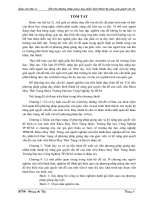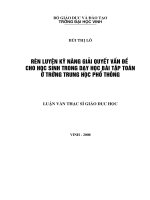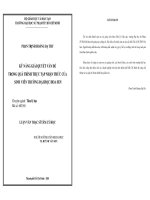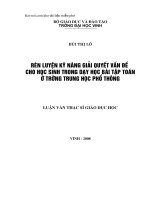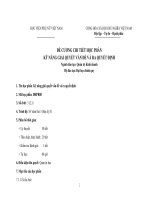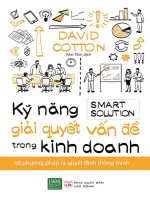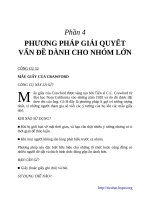Đánh giá kỹ năng giải quyết vấn đề
Bạn đang xem bản rút gọn của tài liệu. Xem và tải ngay bản đầy đủ của tài liệu tại đây (525.24 KB, 86 trang )
ASSESSING PROBLEM SOLVING SKILLS AMONG
PRE-SERVICE AND IN-SERVICE TEACHERS WITH
REGARDS TO ACADEMIC
SKILL DEFICITS
By
SARAH BANKS
Bachelor of Science in Child Learning & Development
Bachelor of Art in Psychology
University of Texas at Dallas
Richardson, Texas
2009
Master of Science in Educational Psychology with an
option in School Psychometrics
Oklahoma State University
Stillwater, Oklahoma
2010
Submitted to the Faculty of the
Graduate College of the
Oklahoma State University
in partial fulfillment of
the requirements for
the Degree of
DOCTOR OF PHILOSOPHY
July, 2014
ASSESSING PROBLEM SOLVING SKILLS AMONG
PRE-SERVICE AND IN-SERVICE TEACHERS WITH
REGARDS TO ACADEMIC
SKILL DEFICITS
Dissertation Approved:
Dr. Gary Duhon
Dissertation Adviser
Dr. Terry Stinnett
Dr. Benjamin Solomon
Dr. Dale Fuqua
.
ii
ACKNOWLEDGEMENTS
This entire study would not have been possible with the support and
encouragement I received from numerous individuals. Many people took time out of
their lives to ensure I successfully completed the study and that I kept my passion for it
alive. I would first like to thank my scorers, Kathryn Moore and Brandon Harrower,
from the School Psychology graduate program. Thank you for having such positive
attitudes. I would also like to thank Brooks Lord for helping me so many times with
submitting paperwork while I was living out of state.
I am very grateful for my advisor, Dr. Gary Duhon, and for the support he
provided not only with my dissertation, but also with my own personal journey through
graduate school. Thank you for your patience and guidance and for having a passion for
what you do. My other committee members, Dr. Benjamin Solomon, Dr. Terry Stinnett,
and Dr. Dale Fuqua are also very deserving of acknowledgement. Your feedback was
valuable and helped keep me on track.
Lastly, I would like to thank my family, boyfriend, and friends for the
unconditional emotional support that was offered. You all supported me every step of the
way and were always ready to give me a shoulder to lean on when things went less than
perfect. Mom, dad, and Whit, your belief in me carried me through. Thank you for never
doubting me and for your love.
iii
Acknowledgements reflect the views of the author and are not endorsed by committee
members or Oklahoma State University.
Name: SARAH BANKS
Date of Degree: JULY, 2014
Title of Study: ASSESSING PROBLEM SOLVING SKILLS AMONG PRE-SERVICE
AND IN-SERVICE TEACHERS WITH REGARDS TO ACADEMIC SKILL
DEFICITS
Major Field: EDUCATIONAL PSYCHOLOGY, OPTION IN SCHOOL
PSYCHOLOGY
Abstract: Given the importance of student academic success, it is imperative that teacher
preparation programs ensure teachers-in-training, also called pre-service teachers, are
being taught how to successfully identify and analyze the problems of struggling
students. The purpose of the current study was to evaluate whether in-service and preservice teachers differed in measured problem identification and analysis skills. In
addition, the study sought to evaluate whether no instruction, didactic instruction, or
didactic instruction plus modeling would result in the highest measured problem solving
skills among participants. The results indicated in-service teachers possessed greater
problem solving skills than pre-service teachers, and that didactic instruction plus
modeling was the most effective form of instruction for teaching problem solving skills.
No significant differences were found between the control and didactic instruction
conditions. In addition, there was not a significant interaction between the independent
variables. Implications for teacher preparation programs and for how to teach pre-service
teachers problem solving skills are discussed, as well as suggestions for related future
research.
iv
TABLE OF CONTENTS
Chapter
Page
I. INTRODUCTION ......................................................................................................1
II. REVIEW OF LITERATURE....................................................................................7
Link between teacher skill and student success .......................................................7
Theories of effective teaching .......................................................................8
Current training programs for teachers .......................................................12
Instructional method ..............................................................................................15
Didactic .......................................................................................................15
Modeling .....................................................................................................17
Problem solving skills ............................................................................................19
Problem identification .................................................................................20
Problem analysis..........................................................................................21
Teacher problem solving skills....................................................................22
III. METHODOLOGY ................................................................................................25
Study Variables ......................................................................................................25
Research design .....................................................................................................26
Participants .............................................................................................................26
Materials ................................................................................................................28
Procedures ..............................................................................................................33
Analysis..................................................................................................................35
v
Chapter
Page
IV. RESULTS ..............................................................................................................36
Demographic Differences ......................................................................................36
Research Question 1 ..............................................................................................37
Research Question 2 ..............................................................................................37
Research Question 3 ..............................................................................................38
V. DISCUSSION ........................................................................................................39
Research Question 1 ..............................................................................................39
Research Question 2 ..............................................................................................42
Research Question 3 ..............................................................................................43
Strengths of the study.............................................................................................44
Limitations of the study .........................................................................................45
Directions for future research ................................................................................46
Conclusions ............................................................................................................47
REFERENCES ............................................................................................................50
APPENDICES ............................................................................................................56
Demographics Survey: In-Service Teachers ..........................................................63
Demographics Survey: Pre-Service Teachers ........................................................65
Problem Identification and Analysis Questionnaire ..............................................67
PIAQ Scoring Rubric .............................................................................................69
Vignette A ..............................................................................................................71
Vignette B ..............................................................................................................72
Debriefing ..............................................................................................................73
Consent Form .........................................................................................................74
IRB Approval .........................................................................................................77
vi
LIST OF TABLES
Table
1
2
3
4
5
6
7
Page
Demographic Characteristics of Sample ...........................................................57
ANOVA Summary of In-Service Teacher Demographic Variables.................58
ANOVA Summary of Pre-Service Teacher Demographic Variables ...............59
Summary of Univariate ANOVA Tests of Between-Subjects Effects .............60
Mean Composite Scores on the PIAQ by Career Status ...................................61
Tukey Posthoc Analyses for Instructional Conditions......................................62
Mean Composite Scores on the PIAQ Instruction x Career Status ..................63
vii
CHAPTER I
INTRODUCTION
Education in public schools is a continuously transforming domain. Every year, various teaching
strategies regarding issues such as whether reinforcement is beneficial or detrimental to a child
capture the attention of those in the profession of educating children. This is often due to the
ever-evolving research that seeks to support or invalidate theories utilized in education. Another
explanation for the continuous shifting of orientations is that a movement may gain momentum
without empirical validity. The task of educating children is a vital component of the success of a
nation and thus must be carried out with great knowledge and skill. A troubled country has a
lesser chance of survival if it also fails to properly educate the children that will make up its
future.
By the year 2020, the number of children and adolescents enrolled in the public education
system is expected to reach 52.7 million (National Center for Education Statistics [NCES], 2011).
According to the National Assessment for Educational Progress, which assesses students across
the nation to track progress in education, the percentage of 12th Grade students at or above the
proficient level in reading in 2009 was about thirty-eight percent and about twenty-six percent for
mathematics (NCES, 2011). These statistics indicate that by the 12th Grade, a frighteningly
1
large percentages of students remain at unacceptable performance levels in academics.
When examining the question of why more children are not experiencing higher rates of
success within the education system, it is important to assess the training teachers have received.
Unfortunately, little research exists regarding what specific skills a teacher’s repertoire should
include to help maximize student success (Cleven & Gutkin, 1988). The current data from the
National Assessment for Educational Progress, however, suggests this is a critical area deserving
of research due to the low percentage of students that are proficient in basic academics (NCES,
2011).
Research by Begeny and Martens (2006) found that undergraduate students training to
become teachers, also called pre-service teachers, received more training in instructional
strategies and principles than instructional programs and assessment strategies. This is
concerning because in order for a teacher to know the progress a specific student is making, the
teacher must first possess a skill set for assessing and monitoring a student’s academic
performance over time. Instead, it appears teachers’ training focuses more on strategies, such as
peer tutoring, and principles, such as reinforcement, than on how to best assess a student’s actual
knowledge of what he or she is being taught (Begeny & Martens, 2006).
In order to improve the education system, it is essential to examine the link between what
pre-service teachers are being taught and what is actually occurring in the field. It would be naive
to assume that a highly qualified teacher automatically equates to being an effective teacher.
Current research suggests that pre-service teachers can possess skills that enable them to analyze
classroom instruction strategies and to then collect evidence to support their effectiveness
(Morris, 2006). Research has documented an obvious failure in the ability to generalize effective
teaching strategies learned as a pre-service teacher and those actually employed as an in-service
teacher (Scheeler, 2008). The deterioration of skills learned as a pre-service teacher may begin to
2
emerge as early as the student teaching experience, suggesting that some significant knowledge of
effective teaching strategies is lost even before graduation (Scheeler, Bruno, Grubb, & Seavey,
2009). This also has implications for children learning new material, suggesting that ineffective
teachers may aid a child’s low academic performance over time. How can we expect children to
thrive academically if their own teachers cannot maintain and generalize knowledge of the use of
effective teaching strategies?
A teacher must also possess a skill set that allows him or her to recognize when a student is
failing to make adequate progress in the classroom and what needs to happen after such a student
has been identified. This ability is often referred to as problem solving. The better a teacher’s
problem solving skills are, the more effective he or she is likely to be as a teacher (Begeny &
Martens, 2006). The skills to be taught should include problem identification and problem
analysis, which will then lead to successful identification of solutions and monitoring of progress
toward a specific goal (Watson & Kramer, 1995).
An effective problem solving model should contain components for problem identification,
problem analysis, intervention design and implementation, and progress monitoring (Ysseldyke &
Martson, 1998). The problem solving process should be driven by empirically-based practices.
Such a source of information will help ensure that a decision-making team is knowledgeable in
determining when modifications to an intervention are necessary. A wait-to-fail model should
have no place in an environment that is meant to foster student success. Instead, practitioners
should seek to define what a problem is, why it is occurring, what needs to be done about it, and
if the given solution has been effective at mediating the problem (Tilly III, 2002).
The steps of the problem solving process are straightforward and can be applied to problems
of varying intensity, severity, and duration. The components of the model that must be altered as
the dynamics of the problem change are the resources necessary and the intrusiveness of the tools
3
and procedures used (Ysseldyke & Martson, 1998). While a minor problem may require a
teacher to implement a simple intervention that does not require many resources, another more
complicated and serious problem may require the involvement of multiple school professionals to
successfully implement the problem solving process. With this in mind, it is of great importance
that a problem is properly identified and analyzed before the proper solution can be utilized.
Teachers can play a vital role in the problem solving process, especially during the problem
identification and analysis phases. In the classroom, teachers have invaluable interactions with a
child that can greatly aid in understanding a problem, what can be contributing to it, and any
potential solutions. Teachers usually have the greatest amount of interactions with a child, and as
such, they are the school personnel that usually refer students and will run an intervention once
it’s been proven effective.
When teaching problem solving skills to teachers, how the information is delivered is
important. A notable obstacle is the overall lack of empirical evidence regarding the components
of the consultative process for teaching problem solving skills that produce the best outcomes.
The current knowledge of the process in the field has comes from inferences from information
based on future referrals, self-reports, and other subjective measures (Cleven & Gutkin, 1988).
One common instructional method used in teaching new skills is didactic instruction, which
involves dispersing information through a lecture format. While didactic instruction is widely
used, research has shown that overall the instructional method is ineffective (Ziarnik & Bernstein,
1982). Other methods, such as modeling, have proven more effective at teaching new skills
(Cleven & Gutkin, 1988). Modeling becomes even more effective as an instructional method
when it is combined with other methods, such as didactic instruction, and even more enhanced
when a performance feedback component is added, which often increases the likelihood of the
generalization of the newly taught skills across contexts (Watson & Kramer, 1995). Overall,
4
research has shown that in order to develop a teacher’s problem solving skills a simple verbal
exchange is likely not sufficient to produce satisfactory results.
Not only do the issues discussed have serious implications for pre-service teachers and those
already in the field, but they are also important for those responsible for training teachers. A
trainer must first know how to teach problem solving skills to teachers before he or she can even
attempt to do so. It is also important for a trainer to be aware of the impact problem solving skills
can have on a student’s success within the context of the classroom. The overall goal is to
provide a skill set to teachers that will enable them to appropriately treat a student’s academic
struggles, and then to know how to treat similar academic deficits that arise in the future.
Research by Watson and Kramer (1995), indicated that training for pre-service teachers
includes more courses on behavior management techniques than specific problem solving skills.
If teachers are not being given enough instruction on how to identify and analyze a student’s
academic struggles, then how can they be expected to be successful (Watson & Kramer, 1995)?
Watson and Kramer (1995) also found that many teacher training programs utilized didactic
instruction as the main instructional method for teaching problem solving skills. According to
research, the best methods of instruction require that teachers be told how to problem-solve, have
it modeled for them, and then have them practice the skills with a component of performance
feedback. Watson and Kramer (1995) note that regardless of what medium is used to teach
problem solving skills, whether through video vignettes or verbal exchanges, the problem solving
steps remain unchanged.
Given the importance of student academic success, it is imperative that research be conducted
to further address the ability of teachers to utilize methodologies, like problem solving, to
improve academic outcomes for students. The purpose of this study will be to evaluate the
degree to which teachers possess basic problem solving skills and whether those skills can be
5
improved by providing some form of relevant instruction. Therefore, this study seeks to answer
the following questions. Do pre-service and in-service teachers differ with problem solving skills
with regards to academic skill deficits? What instructional method will result in the greatest
measured problem solving skills among participants? Lastly, is there an interaction between the
variables instructional method and career status? It is hypothesized that in-service teachers will
score higher on a measure of problem solving skills than pre-service teachers. In addition, a form
of instruction that provides modeling will be superior in comparison to didactic instruction and
receiving no instruction, and those that receive no instruction will score significantly lower than
the other two instructional conditions. It is also hypothesized that there will be a significant
interaction effect between the career status and instructional method variables.
6
CHAPTER II
REVIEW OF LITERATURE
The Link Between Teacher Skills and Student Success
Regardless of the importance of examining why more children are not experiencing higher rates
of success within the education system, little research exists regarding what specific skills a
teacher’s repertoire should include (Cleven & Gutkin, 1988). In order for a teacher to know the
progress a specific student is making, the teacher must first possess a skill set for assessing and
monitoring a student’s academic performance over time. Instead, it appears teachers’ training
focuses more on strategies, such as peer tutoring, and principles, such as reinforcement, than on
how to best assess a student’s actual knowledge of what he or she is being taught (Begeny &
Martens, 2006).
It would be naive to assume that a highly qualified teacher automatically equates to being
an effective teacher. Current research suggests that pre-service teachers can possess skills that
enable them to analyze classroom instruction strategies and to then collect evidence to support
7
their effectiveness (Morris, 2006). However, the documented deterioration of skills learned as a
pre-service teacher suggests that some significant knowledge of effective teaching strategies is
lost even before graduation (Scheeler et al., 2009). This also has implications for children
learning new material, suggesting that ineffective teachers may aid a child’s low academic
performance over time.
Theories of effective teaching
It would be naive to assume that a highly qualified teacher automatically equates to being
an effective teacher. Ineffective teachers have the potential to greatly contribute to a child’s poor
academic performance. At the same time, a highly effective teacher can positively affect a
child’s academic success. The value of the teaching profession is in part determined by the
results brought by those in the profession (Carpenter, 1900). If the field is overwhelmed with
ineffective teachers who do not help children succeed, then we can expect teachers to be
devalued.
The differentiation between effective and ineffective teaching strategies is not always
readily discernible. In 1994, Ellis, Worthington, and Larkin produced a technical report for the
National Center to Improve the Tools of Educators that outlined ten teaching principles
demonstrated as effective by research. The results of the research synthesis by Ellis et al. (1994)
described effective teachers as ones that encourage students to be actively engaged during
instructional activities. In addition, effective teachers provide increased opportunities to learn,
which is most often implemented using large or whole group instruction. Effective teachers also
encourage students to become self-regulated learners by carefully scaffolding instruction (Ellis et
al., 1994).
Teachers should also foster learning through helping students organize, store, and retrieve
knowledge by using semantic features analyses, study guides, organizers, anchored instruction,
8
and semantic mapping (Ellis et al., 1994). Strategic instruction should also be used by teachers to
allow students to use existing knowledge in such a way that will enable them to learn new
material, and should include scaffolding, monitoring, and evaluation. Instruction should be
explicit and utilize goals, objectives, expectations, lesson structures, presentations, and
instructional content that will allow students to become self-regulated learners (Ellis et al., 1994).
The terms used to describe an effective teacher are more congruent with how a qualified
teacher is described, which is as someone who has a bachelor’s degree and full certification in the
state he or she teaches (Brown, Morehead, & Smith, 2008). The criteria used to describe
effective teachers make no mention of their instructional strategies or behavior modification
techniques, among other things. Instead, the terms used merely describe if a teacher has
completed the minimum requirements in order to become a teacher.
A common question that arises when discussing theories of effective teaching is if
teacher qualifications really have an impact on student success. Research has revealed that the
answer to the question is that certain teacher qualifications can indeed impact student success
(Croninger, King Rice, Rathburn, & Nishio, 2004). For example, teachers with degrees in
elementary education and who have two or more years of experience as a first grade teacher are
associated with students with higher achievement in reading than teachers who do not hold those
qualifications (Croninger et al., 2004).
Thirty years ago, it was thought that the only necessary characteristic a teacher needed in
order to be effective was that he or she liked children (as cited in Brown et al., 2008). More
recently, observations of teachers with high-performing students reveal that effective teachers
often utilize direct instruction and are respectful but yet demanding of their students (Poplin &
Soto-Hinman, 2006). It appears that to be effective, teachers must do much more than just like
the population they work with.
9
While our country has seen an outpouring of policies enacted to promote higher quality
standards for teachers, there has been a notable lack of agreement on how to recognize effective
teaching (Kane, Taylor, Tyler, & Wooten, 2010). Some school districts across the country are
beginning to use student achievement as a direct measure of the effectiveness of a teacher, while
others purely use classroom observations (Kane et al., 2010). Among the issues that have risen
with using student achievement gains as measures of teacher effectiveness is that using test-based
measures of student achievement does not inform administrators of how to improve teaching
practices (Kane et al., 2010).
Similar to college entrance exams, using test-based measures of student success may only
demonstrate the areas a student is lacking proficiency in, but does not offer guidance for how to
improve the teaching practices that may have led to such academic skill deficits. This basic lack
of information about effective teaching could potentially lead teachers to focus more on teaching
students how to successfully take state tests rather than about vital content in the curricula. If,
somehow, student achievement gains on state tests were a reliable and valid measure of teacher
effectiveness, the practice still wouldn’t inform administrators about how to replicate such
teachers (Kane et al., 2010). It becomes evident that identifying effective teachers is not enough
to inform teacher practices.
It is easy for those not in the teaching profession to criticize the practices of those that are
in the profession. Being a teacher can be a very demanding job, both emotionally and physically.
They must plan, implement, and monitor practices that were put in place to enhance student
achievement. Teachers must also incorporate the demands of their district and state, which can
be a confusing and overwhelming task (Danielson, 2007). District or state frameworks for
teaching can be a source of relief for teachers, especially those new to the field, because they
make expectations and guidelines more straightforward. Essentially, frameworks outline best
practices for those in the field and can be easily understood by novice and veteran teachers. It is
10
important to note that simply using any framework for teaching will most likely not be enough to
produce effective teachers. These frameworks should be developed based on research that
identifies best practices related to improving student achievement.
Numerous frameworks for teaching have evolved in an effort to promote effective
teaching practices. A prominent framework developed by Danielson (2007), outlines four
domains with a total of twenty-two components that define best practices of teachers. Domain
One, titled Planning and Preparation, states that teachers should be able to demonstrate their
knowledge of content, students, and resources, as well as set instructional outcomes, and design
coherent instruction and student assessments. When designing student assessments, teachers
should make them so that they are congruent with instructional outcomes and are useful for
instruction planning purposes. Domain Two, titled The Classroom Environment, states teachers
should be able to create an environment of respect and rapport, establish a culture for learning,
manage classroom procedures, and manage student behavior and the organization of physical
space. A component of Domain Two that is of importance is the expectation that teachers
properly monitor and respond to misbehaviors in the classroom (Danielson, 2007).
Domain Three of the framework, titled Instruction, states teachers should communicate
with students, use questioning and discussion techniques, engage students in learning, use
assessments in instruction, and demonstrate flexibility and responsiveness in the classroom
(Danielson, 2007). Essentially, teachers should ensure student participation and monitor student
learning. The last domain, Domain Four, titled Professional Responsibilities, says teachers
should reflect on their teaching, maintain accurate records, communicate with students’ families,
participate in a professional community, ensure professional growth, and show professionalism.
Of importance here is that teachers should reflect on their own teaching skills so they can ensure
information is being taught accurately. They should also be able to improve their teaching
methods if found unsatisfactory (Danielson, 2007).
11
Current Training Programs for Teachers
In 2004, The Teaching Commission, which is a group of education, business, and
government leaders, published a call to action with policy recommendations built in part to
ensure teachers continue to strive for excellence in the field. The commission stated that over the
next ten years, at least two million new teachers will need to be hired across the country. How
will the field successfully fill these positions as states continue to redefine what an effective,
quality teacher is? The report by The Teaching Commission (2004), suggests that as a country,
we have set low standards for teacher preparation and licensure. Do we then blame teachers or
the institutions that trained them for the low performance of students? The answer doesn’t appear
to be clear-cut.
In 2010, the National Commission on Teaching and America’s Future (NCTAF)
published a research report about the current teacher workforce and its implications. The study
found that nearly half of current teachers are approaching the age for retirement (NCTAF, 2010).
In contrast with the data published by The Teaching Commission (2004), the NCTAF (2010)
cites studies estimating that anywhere between almost three million and five million new teachers
will need to be hired by the year 2020. The NCTAF (2010) also states that the attrition rate
among new teachers has continued to worsen over the last fifteen years. The looming loss of a
large amount of veteran teachers and the already occurring loss of newly hired teachers has the
potential to create a workforce with little experience (NCTAF, 2010). With this in mind, it is no
surprise that universities and school districts across the country are scrambling to train and find
highly qualified teachers.
Research has documented an effect of a teacher’s years of experience on the achievement
of students (NCTAF, 2010). In 1996, the NCTAF published a report with proposals for preparing
and supporting teachers across the country. According to the report, almost twelve percent of
12
new teachers are hired even when they lack any training, and about fourteen percent are hired
without fully meeting state standards (NCTAF, 1996). Someone cannot be hired as a plumber or
a hair stylist without successfully completing the required training and passing a formal
examination, but in almost every state someone can be hired as a teacher even if they have failed
to meet the position’s basic requirements. The matter becomes even more complicated in poor
school districts, in which there has been high teacher turnover and lax hiring policies (NCTAF,
1996).
Researchers have long been looking for the answer for how to prepare pre-service
teachers to become successful, effective teachers in the field. Instead of being able to identify
what works, research seems to be more capable of identifying problems with teacher preparation
programs. For example, the NCTAF (1996) identified issues such as inadequate length of time of
preparation, stating that four years in an undergraduate program is insufficient to produce quality
teachers. Other issues in teacher preparation programs include fragmentation of key parts of
teacher learning, uninspired teaching methods, a lack of instruction on how to handle actual
problems of practice, and a lack of learning how to collaborate (NCTAF, 1996). The Teaching
Commission (2004) called on universities to raise the standards for allowing someone to enter a
preparation program, as well as ensuring a connection is made to practicing in the real world.
The Teaching Commission (2004) also recommended that universities require students majoring
in education to receive a minor in an academic subject, like math, and for faculty to teach
practices that have empirical support.
Practices pre-service teachers should be taught include instructional interventions that are
empirically supported, the purposes of research in education and how to evaluate it, and how to
communicate knowledge with other practitioners (Greenwood & Mabeady, 2001). Without this
knowledge, new teachers may fall victim to practices that do not improve student performance, or
worse, hurt student performance. In order to implement research-based practices, teacher
13
preparation programs should demand students to reference research when making decisions about
instruction. Programs should also teach students how to find relevant literature as well as how to
interpret and analyze research findings (Greenwood & Mabeady, 2001). Essentially, pre-service
teachers should be able to translate research into practice once in the field.
Even when an institution enacts the basic procedures to prepare teachers for their career,
there are still noticeable differences between what some are being taught to do and what they’re
actually doing once in the field (Scheeler et al., 2009). The completion of coursework and
student teaching requirements does not necessarily equate to the maintenance and generalization
of the teaching skills learned as an undergraduate. In some cases, thirty percent or less of the
skills pre-service teachers learn will actually be used once they are in-service teachers
(Englemann, 1988). Where is the missing link between the skills being taught to pre-service
teachers and the skills being used by new teachers? A research synthesis by Scheeler (2008)
revealed four factors that may help teachers sustain the skills taught to them in college. The
factors include immediate feedback when teaching new skills, training to mastery, programming
for generalization, and providing pre-service teachers with feedback in applicable settings (as
cited in Scheeler et al., 2009). Ideally, these procedures would be incorporated into all training
programs and would be implemented by properly trained supervisors.
Research has documented a deterioration of skills from undergraduate courses to student
teaching, which is highly alarming (Scheeler et al., 2009). This implies pre-service teachers
begin to lose newly acquired skills before they graduate and enter the field. How can teachers be
successful if they began losing knowledge they gained before they even received their degree?
Obviously, more must be done to ensure pre-service teachers not only maintain what they are
taught, but can also generalize the knowledge across settings. This issue in pre-service teacher
training not only affects the teacher, but also affects the children he or she will eventually be
teaching.
14
Instructional Methods
When teaching new material to someone, how the information is delivered is an
important factor in how much that person learns. One common instructional method used in
teaching new skills is didactic instruction, which involves dispersing information through a
lecture format. While didactic instruction is widely used, research has shown the instructional
method to be overall ineffective (Ziarnik & Bernstein, 1982). Other methods, such as modeling,
have proven more effective at teaching new skills (Cleven & Gutkin, 1988). Modeling becomes
even more effective as an instructional method when it is combined with other methods, such as
didactic instruction, and even more enhanced when a performance feedback component is added,
which often increases the likelihood of the generalization of the newly taught skills across
contexts (Watson & Kramer, 1995).
Didactic Instruction.
Didactic instruction is the teacher-centered presentation of material that requires the
student to assume the role of a passive learner (Smerdon, Burkam, & Lee, 1999). The method
has in large part been proven ineffective in comparison to active methods of instruction, such as
modeling (Graham & Wong, 1993; Sterling-Turner, Watson, Wildmon, Watkins, & Little, 2001;
Neef et al., 2004). Despite this knowledge, didactic instruction continues to play a prominent
role in education (Omelicheva & Avdeyeva, 2008). The instruction method appears to be useful
in educating someone in the basic knowledge of a particular subject (Omelicheva & Avdeyeva,
2008) rather than how to apply such knowledge.
When reviewing the effectiveness of didactic instruction, the analyst should envision an
elementary school classroom that contains thirty students and one teacher. The teacher is
lecturing the entire class about how clouds are formed. How likely is it that all thirty students are
actively engaged for the entire duration of the lecture? The format of didactic instruction does
15
not allow a teacher to check that every student is grasping the material being covered. This
problem is even more compounded by larger classrooms, like at universities where sometimes
hundreds of students are in attendance.
A review of the literature regarding the effectiveness of didactic instruction found that the
teaching method was as effective as other methods were for delivering content information
(Bligh, 2000). The criteria for evaluating effectiveness were that students demonstrated
acquisition of information. However, it is important to note that this review of research did not
demonstrate that didactic instruction was more effective than any other teaching method at
ensuring student acquisition of knowledge (Bligh, 2000).
A potential strength of the didactic method of instruction is that it can be utilized almost
anywhere, as it requires few resources, unlike what might be necessary for a practicing
component of modeling with rehearsal feedback. It can also be applied with almost any content
area, as almost all that is required is simply a source of information from which to draw lecture
materials from (Broadwell, 1980). Didactic instruction is also efficient in that a teacher simply
needs to present information and move on to new material without necessarily checking for
mastery of the information from his or her pupils. The instruction method can be effective when
a teacher makes an effort to connect the lecture content to related student activities (Chaudhury,
2011). Teachers can also include a carefully structured process of questioning students during
lectures to allow students the chance to correct any misunderstandings they may have of the
material (Chaudhury, 2011).
Didactic instruction, when used as the main method of teaching in a classroom, has the
potential to harm student attitudes toward the material covered in class (Bligh, 2000). If students
feel as though their success in the mastery of material covered during lectures is not valued,
16
which could arguably be demonstrated in this teacher-centered approach, then it is reasonable to
assume students may not value their own mastery of the content knowledge.
Modeling Instruction.
Another method for relaying information is through modeling, which is a more studentcentered approach than didactic modeling. This teaching method creates visible representations
of information presented, such as the key properties of written language (Martin, 1999).
Listening to a lecture about the features of written language is probably not as effective as
actually being able to see the information come to life with examples. In regards to teachers, how
can we expect teachers to teach others about issues such as proper error correction methods if
they have never seen it in action themselves? The ability to describe something does not
automatically equate to being able to actually correctly perform the task related to the content
knowledge.
When someone is being taught through modeling, it is the teacher’s responsibility to help
that person understand what is being relayed through visible examples of applications of the
material (Goslin, 2012). Modeling should be viewed as a form of communication that is strategic
(Goslin, 2012). As such, this instructional method may be more time-consuming than didactic
instruction alone. It engages the learner and gives the opportunity to see the relationship between
a strategy and the use of it (Neef et al., 2004). A weakness of modeling instruction, and
potentially a weakness of all instructional strategies, is that observation of a strategy does not
necessarily mean observers have learned the strategy or will be able to carry it out independently
(Rosen et al., 2010).
When exploring various research studies that have modeling included in an independent
variable, it is obvious that the term is loosely applied in numerous situations. The term has been
used interchangeably with observational learning and imitation, which are separate and distinct
17
terms (Rachman, 1972). Instead, modeling should be considered as a form of social imitation
rather than as being synonymous with observational learning and imitation (Rachman, 1972).
Not only does modeling aid in the elimination of unwanted behaviors, but it also aids in the
development of desired behaviors.
If taking students to a live setting to observe something like child behavior is not
possible, then modeling can serve as a means for demonstrating information without needing to
leave the classroom (Henderlong Corpus & O’Donnell Eisbach, 2005). In other words, modeling
can demonstrate information without taking learners to the environment in which the knowledge
will be applied. It can also foster the connection between prior knowledge. However, this
connection can be harmed if the teacher does not practice what they teach (Higgs & McMillan,
2006). This applies to professors teaching pre-service teachers, and to in-service teachers
teaching children. For example, if a professor is teaching pre-service teachers about using a
variety of instructional methods, and the professor only uses didactic instruction in his or her
course, then this could harm the connections the pre-service teachers are making between what
they’re being taught to do, and how they’re being taught to do it.
Modeling has been demonstrated to increase social skills, such as eye contact (Edelstein
& Eisler, 1976) and sharing (Elliott & Vasta, 1970), and fear of particular stimuli, such as snakes
(as cited in Rachman, 1972). Elliott and Vasta (1970) note that the addition of explanations while
modeling can make clear the nature of the desired response as well as emphasizes this by eliciting
rehearsal of what is to be done or what has been demonstrated. The effects of modeling can also
be enhanced by adding reinforcement and feedback for the learner (Elliott & Vasta, 1970;
Edelstein & Eisler, 1976). However, research by Watson and Kramer (1995) found contradictory
results with regards to the enhanced effects of modeling when paired with feedback. The
researchers found that while modeling was more effective than didactic instruction was for
18
